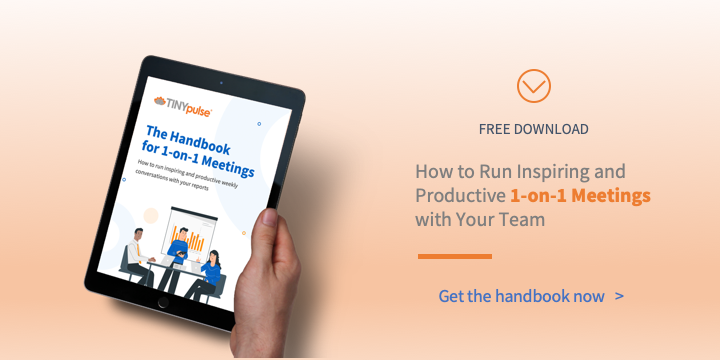22 Employee Survey Questions to Help You Create Better Growth & Development Opportunities at Work
As leaders, we know investing in growth and development keeps our employees engaged.
It helps us develop a strong workforce and retain our best employees. And most organizations try their hardest to offer ample growth and development opportunities.
According to Training Industry reports, spending on employee training and development rose from just over $70 billion in 2015 to more than $83 billion in 2019 — a sizable increase of $13 billion.
Unfortunately, there has been little to show for these additional investments.
Just before COVID hit, TINYpulse research found that only 26% of employees felt they had a lot of growth opportunities at their organization — a figure that’s remained steady since 2015, when it clocked in at 25%.
In other words, after four years of improvements, the amount of employees who feel they have adequate professional growth opportunities has increased by just 1%.
With the unique challenges 2020 has brought, it’s more vital than ever that we rethink how we approach employee growth and development.
We need to ensure our programs are what our employees need from us right now and they are inclusive for everyone.
Adapting growth and development programs in light of COVID-19
Seemingly overnight, COVID-19 forced an estimated 95% of workers in America to switch to telecommuting. Although many companies are beginning to bring employees back to the office, just as many (if not more) plan to continue remote working for the foreseen future.
This has no doubt had an impact on workplace learning programs and professional growth opportunities for employees. With things like job shadows and in-person learning temporarily on pause, we must be resilient and adapt our strategies accordingly.
To do that, we need our employees' input.
Employee growth and development survey template
Every employee growth and development program should be based on what our employees want and need to succeed.
It shouldn’t just focus on increasing the skills employees need in their current positions. It also needs to support their career development and give them a roadmap to follow.
By using this growth and development template, you can get a baseline understanding of how your organization's growth and development program stacks up.
Using your results, you can create more meaningful and inclusive development opportunities for your employees.
REA MORE: 14 EMPLOYEE SURVEY QUESTIONS ABOUT MANAGEMENT EFFECTIVENESS
Sample employee survey questions about career paths
1. I feel that I am in control of my career path and that I am progressing in my personal and professional development at this company.
No, Yes
2. Is your promotion and career path clear to you?
No, Yes
3. I understand the criteria I must meet to be promoted.
1 being strongly disagree, 5 being strongly agree.
4. I can predict my future career path in this organization by observing other people's experiences.
1 being strongly disagree, 5 being strongly agree.
Giving your employees a clear career path
In today’s turbulent times, employees want certainty — certainty in your organization’s stability and certainty that they have a career path within your company.
Research shows that 76% of employees want opportunities for career growth. Providing your employees with career options that align with their strength and interests can increase engagement and improve retention.
If your results are lower than you expected for this section, take a closer look at your promotion and hiring practices, and information being shared with your employees.
Promotion and hiring practices
Is there a hiring standard for certain positions? Are your managers being consistent and transparent in the hiring process?
Being open about the required qualifications for certain positions and promotion criteria ensures your employees are treated equitably.
Try to look beyond a college degree when you can.
A reported 67% of the population will never have a four-year degree. That’s almost two-thirds of the workforce you’re missing out on and this can severely limit many of your employees promotional opportunities.
READ MORE: 30 QUESTIONS TO ASK YOUR NEW HIRES DURING EMPLOYEE ONBOARDING
Share promotional qualifications with your employee
After you have set hiring and promotional standards, work with your HR team to create a plan to help employees find a path that’s right for them.
Some ideas include:
- Publishing job qualifications on your internal HR site
- Holding an internal career fair where employees can learn about different careers you offer
- Recording and post videos of employees who were internally promoted sharing what they do and how the steps the took to get the position
- Coaching managers on how to have conversations about career goals
- Soliciting your HR team to provide strengths-based assessments to employees who'd like it
Sample survey questions about professional development
5. How well does our organization support you in exploring your professional interests and goals?
1 being extremely unsupportive, 5 being extremely supportive.
6. Do you feel challenged at work on a daily basis?
No, Yes
7. How much opportunity do you have for professional growth in this organization?
1 being no opportunity, 5 being unlimited opportunity.
8. Do you feel like you'll have the opportunity to reach your full potential at our organization?
1 being no way, 5 being very much so.
9. I am satisfied with my chances for promotion.
1 being strongly disagree, 5 being strongly agree.
10. I would be very happy to spend the rest of my career with this organization.
1 being strongly disagree, 5 being strongly agree.
11. My company promotes from within.
1 being strongly disagree, 5 being strongly agree.
12. I have the opportunity to develop my full potential.
1 being strongly disagree, 5 being strongly agree.
Providing your employees with professional development opportunities
Believe it or not, 7 out of 10 employees say that professional development affects whether they will stay with a company. By providing more professional development opportunities, you can increase retention and build a strong, more adaptable workforce.
Professional development is a broad umbrella that includes everything from coaching to succession planning. By asking your employees how they feel about the opportunities they have, you can see which areas could be enhanced.
A Society for Human Resources Management (SHRM) article offers a great starting point for development opportunities to consider incorporating into your growth and development strategy.
Some ideas to try to include are as follows:
- Career coaching: working with their supervisor or trained staff to set career goals and create a development plan
- Mentorship: connecting employees with a mentor who can support their career development
- Stretch assignments: temporary developmental job assignments to learn new skills and gain on-the-job experience
- Online employee development: providing short, eLearning opportunities to help your employees develop new skills
Sample survey questions about employee development investments
13. My company puts a high value on employee satisfaction.
1 being strongly disagree, 5 being strongly agree.
14. I have a good level of job security.
1 being strongly disagree, 5 being strongly agree.
15. We all have dreams and goals on our bucket list. It could be anything from running a marathon to learning another language to writing a book.
What are two things on your bucket list? ______________________________
Investing in your employee’s professional development
Did you know that 94% of employees would stay with a company longer if the organization invested in learning? ASTD also found that companies that invested more in training were 24% more profitable than those that did not.
Whether your employees feel you place a high value on employee satisfaction and their feelings of job security are very telling about your overall company culture.
Compare these particular responses to your other survey categories to see which factors are contributing most to lower ratings.
Sample survey question about mentors
16. Do you have a mentor at work?
No, Yes
Providing access to mentors
Having a mentor is one of the top ways to ensure your employees are engaged.
In fact, 9 in 10 employees who have mentors say they are happy in their jobs. On the flip side, more than 4 in 10 workers who don’t have a mentor say they’ve considered quitting their job in the past three months.
Although most mentorships are developed naturally, your organization can help facilitate relationships, provide support to mentors, or even start your own mentorship program.
Start with a vision then get a diverse group of employees together to spearhead your initiative. Getting input from all areas of your organization will help ensure your mentorship program is more effective.
Sample survey questions about role orientation
17. Do you feel that your manager has clearly defined your roles and responsibilities and how they contribute to the success of the organization?
No, Yes
18. How well do you feel you're fulfilling your role?
1 being poorly, 5 being very well.
Ensuring employees have clear role orientation
Our employees work better when they have clearly defined roles. When each team member knows what’s expected of them, they are more productive and can better see how they contribute to the bigger picture.
If your survey results indicate your employees’ don’t feel their role is clearly defined or they don’t feel they contribute to your organization’s success, follow up with your managers and employees.
A second anonymous employee survey can help you better understand the situation. Ask your employees about any barriers that prevent them from meeting their responsibilities and what additional resources they need.
Find out what your managers are currently doing and have your HR team available to assist them with defining roles and responsibilities, if necessary.
Regular one-on-one meetings in your workplace can also help employees feel more confident in their role and improve relationships. If your managers aren’t currently holding one-on-ones, HR can help coach managers on how to successfully run these meetings.
Taking the time to solidify your employees’ roles and work on creating a shared vision will not only increase productivity. It will also engage your workers and help them envision a future with your company.
Sample survey questions about training opportunities
19. This job allows me to sharpen my professional skills.
1 being strongly disagree, 5 being strongly agree.
20. In terms of training and professional development, what would you like to see us offer or continue to offer? ________________________
21. What additional training or education would help you better do your job? __________________________
22. Which department at our organization would you like to learn more about?
______________________________
Giving your employees the right training opportunities
It’s no secret that employees want to have training opportunities. But offering them is meaningless if it isn’t doesn’t provide the results they need.
By surveying your employees, you can learn what training they need to support them in their current job. Although in-person training may not be an option for a while, LinkedIn Learning, Coursera, and other online platforms offer courses for a relatively inexpensive price.
Your survey results will show you the type of professional development opportunities your staff would like to have and the areas of your company they want to know more about.
By comparing this to your “career ladder” and “professional development” results, you can better get an idea of what your employees are most interested in.
How do your employees feel about the opportunities they have?
Providing your employees with the right growth and development opportunities empowers them to do their current job and keeps them engaged.
Rather than defaulting to formal training classes, it’s time we take a different approach to workplace learning and development.
Instead of guessing what our employees need, let’s get their feedback.
Your survey results will give you the insights you need to create inclusive and effective growth and development opportunities. By offering enough learning opportunities, you will create and cultivate a highly engaged workforce that is ready to knock it out of the park every day. What’s not to like?
Share this
You May Also Like
These Related Stories







.png?width=534&height=632&name=blog%20ad%20(1).png)
